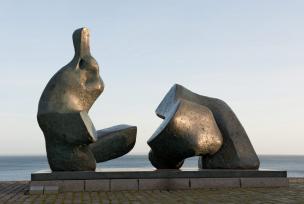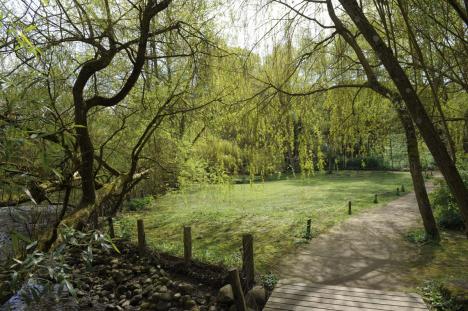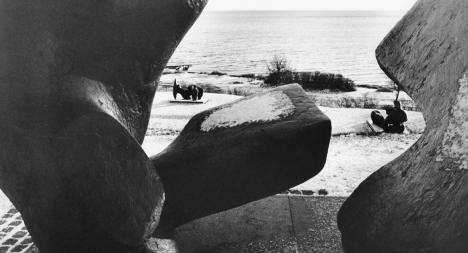
WHEN ART IS AN ICON FOR A PLACE
When you step inside Louisiana and then out into the museum park, Henry Moore’s Two Piece Reclining Figure No. 5, is one of the first things you see when you look toward the horizon. It creates a visual profile for the place, and for many people the sculpture has grown into something they associate with Louisiana – a sort of icon. Although the sculpture was not created for the site, you could say that over time it has become the site.
Moore at Louisiana – but where?
Early in the Louisiana’s history, Knud W. Jensen, the museum’s founder, had a vision of acquiring works by the British sculptor Henry Moore. In the spring of 1967, Jensen traveled to England and visited Moore. He was immediately fascinated by the bronze sculpture Two Piece Reclining Figure No. 5, which he believed would fit very well outside in Louisiana’s park.
In the initial dialogue with Moore, they considered placing the work in the newly designed Lake Garden at Louisiana, where it would be surrounded by old trees, steep slopes and the idyllic pond. “Henry Moore would like to see his sculptures placed in such surroundings,” wrote Jensen in a letter to the New Carlsberg Foundation, from which he sought financial support for the work. The sculpture did not end up in the Lake Garden, though, but in a more visible location on the lawn.
For Moore, the reclining figure offered many possibilities, and it was a theme he returned to again and again. By being more upright on one side and still lying down, this version relates to both the horizontal and vertical dimensions of the natural landscape. The location where Two Piece Reclining Figure No. 5 ended up at Louisiana could therefore hardly have been better: With the sculpture on the slope, one has the sea and the horizon as a backdrop and the tall old trees framing it on either side.
“There is no better background for a sculpture than the sky [...]. Since there is nothing else that competes with sculpture, no other solid objects that disturb it.”
Henry Moore
More Moore at Louisiana
In 1975, the museum purchased two additional Moore sculptures for Louisiana’s collection. The two new sculptures first stood on the lawn below the slope towards the beach. After a few years, however, the museum found that the location was not working. The sculptures “shrunk” when they were seen from above, and they would also get more space if they were positioned separately. The museum therefore changed the location of the sculptures. At that time, it was decided that Two Piece Reclining Figure No. 5 should yield its place to Three Piece Reclining Figure, since the latter was larger. After a few years, however, the sculpture was returned to its position on the slope – it was as if it belonged there.
Today the three Moore sculptures are positioned so that Louisiana’s guests meet them one at a time. The idea behind this plan is that visitors should be able to experience the variations of Moore’s reclining figure as they walk through the museum and the Sculpture Park.
Moore, who was involved in both the original positioning and the relocation of his sculptures at Louisiana, said this about the location of Two Piece Reclining Figure No. 5 in 1976: “It is one of the best locations my sculptures have gotten. I chose it myself. We removed some trees so that you can see the water behind it. I think there are too many sculptures in the park now, but this sculpture still has a fine position.”
FILM
FACTS
Henry Moore (1898-1986) was a British sculptor and graphic artist who is known particularly for his large sculptures in stone and bronze. He is one of the most important artists of the twentieth century, and his works are found around the world – both inside and outside museums, and in and outside cities.
In the 1930s, Moore represented the British avant-garde (in sculpture) together with Barbara Hepworth, Ben Nicholson and others. In his early work, he was inspired by Romanesque and non-Western art, especially the Mayan Chac Mool figures depicting reclining gods with a sacrificial offering bowls on their stomachs. During World War II, Moore worked as official war illustrator and drew “shelter-drawings” of the many people who sought shelter from the bombardment of London in the city’s subway system. There he got the opportunity to study the reclining bodies of people sleeping in various positions that he later used in his sculptures. His drawings achieved wide recognition and helped to establish Moore as a humanist.
In his sculptural idiom, Moore tends toward the abstract, but his starting point is always a human composition. He works with recurring themes such as “mother and child” and “the reclining figure”.
In addition to Two Piece Reclining Figure No. 5, Moore is represented at Louisiana by the sculptures Reclining Figure from 1969-70 and Three Piece Reclining Figure: Draped from 1974-75.
ACTIVITIES
Find a work of art or a monument that you think is an icon for a place, such as the Eiffel Tower is for Paris. What qualities do you think the work or the monument has?
Teaching tip: You can also involve architecture in this exercise. Find special buildings or a particular building style that one associates with a place and something that people travel far to see.
In this case, Henry Moore’s Reclining Figure Two Piece No. 5 is described as a work of art that has become a kind of icon for Louisiana. There are a number of other works in the Sculpture Park and the museum that could have been used instead. Find another work at the museum that makes you think of Louisiana. Consider why that is so.
Henry Moore felt that sculpture was an outdoor art form. What would happen if you moved Two Piece Reclining Figure No. 5 inside? What would you place on the slope instead of the Henry Moore sculpture?
Make a proposal for a work that can serve as a landmark for your school. What do you think the work should look like? Where would you place it? What signals do you want it to send?
Interdisciplinary project with history/social studies/Danish (other languages):
Many of the works we regard as icons for specific places has achieved this status over time. This also applies to The Little Mermaid from 1913 which has become a landmark for not only for Langelinje and Copenhagen but for the entire nation.
In 2010 The Little Mermaid was moved to Shanghai to be a part of the Expo 2010 exhibition. While The Little Mermaid was abroad a work by the Chinese artist Ai Weiwei was set up instead: a screen with direct images from the pavilion in Shanghai. The thought of the mermaid leaving a place she is so inextricably connected to caused a good deal of resistance but in Shanghai the enthusiasm with having a little piece of Denmark on loan was great.
Consider The Little Mermaid’s role as a national symbol and what it means to have a national symbol. What does the mermaid say about Denmark? Why were there so many complaints when she went to Shanghai? How does it affect Denmark’s image that The Little Mermaid was send to Shanghai? What else could have worked as a national symbol for Denmark?
Tip for students: See Martin de Thurah’s film about the mermaid’s journey to Shanghai on VIMEO. Click here
Tip for students: Read Mikael Frausing’s article MYTHE: Is The Little Mermaid a Danish national symbol? At www.danmarkshistorien.dk (in Danish)
The artist duo Elmgreen and Dragset has worked with The Little Mermaid as symbol both in the work When a Country Falls in Love with Itself (2008) (se below here) and in He (2012), a sea boy who is permanently placed at the harbor in Helsingør (google “Elmgreen & Dragset He” to see a photo of He).
How does the two works contribute to a discussion of The Little Mermaid?














